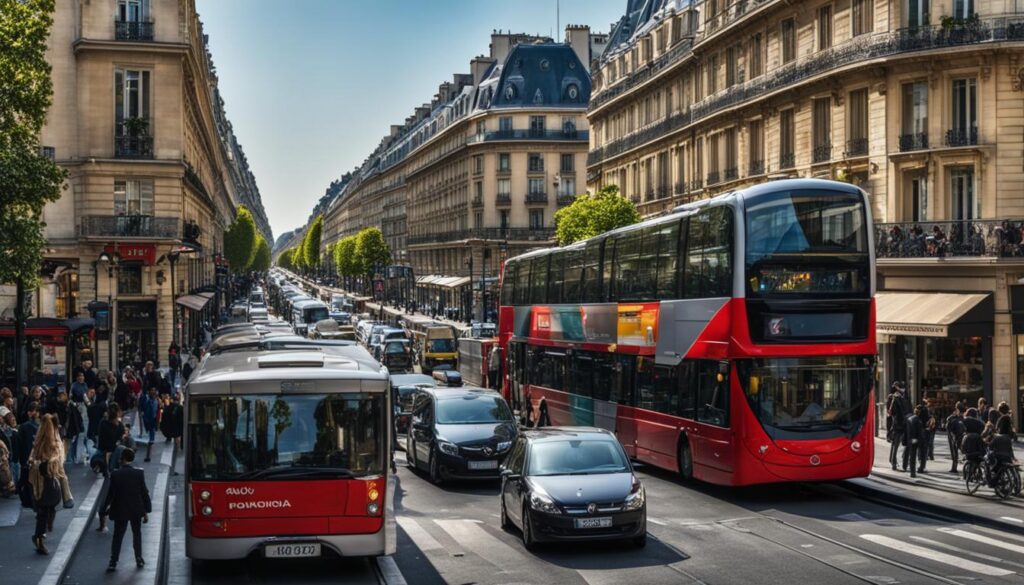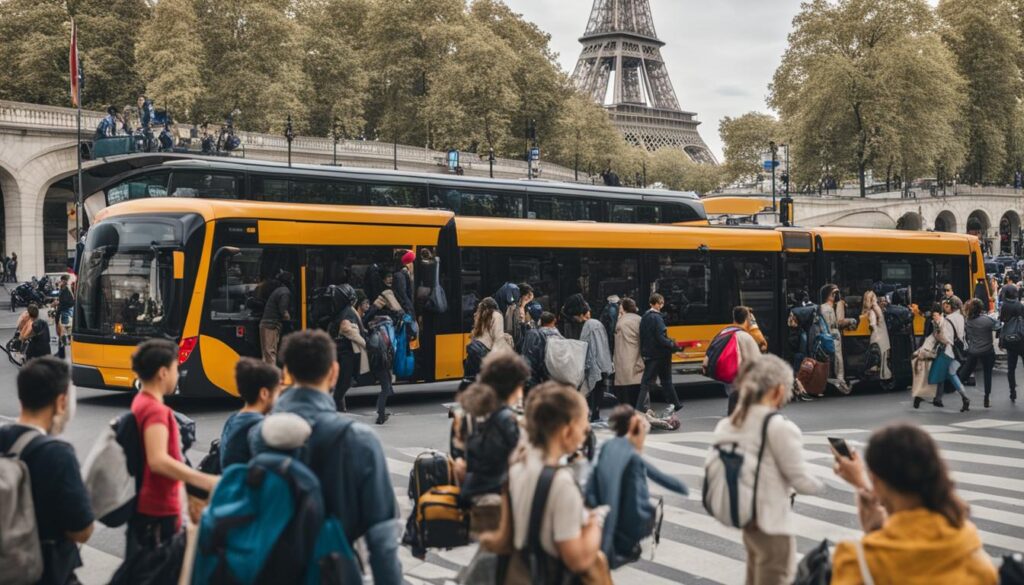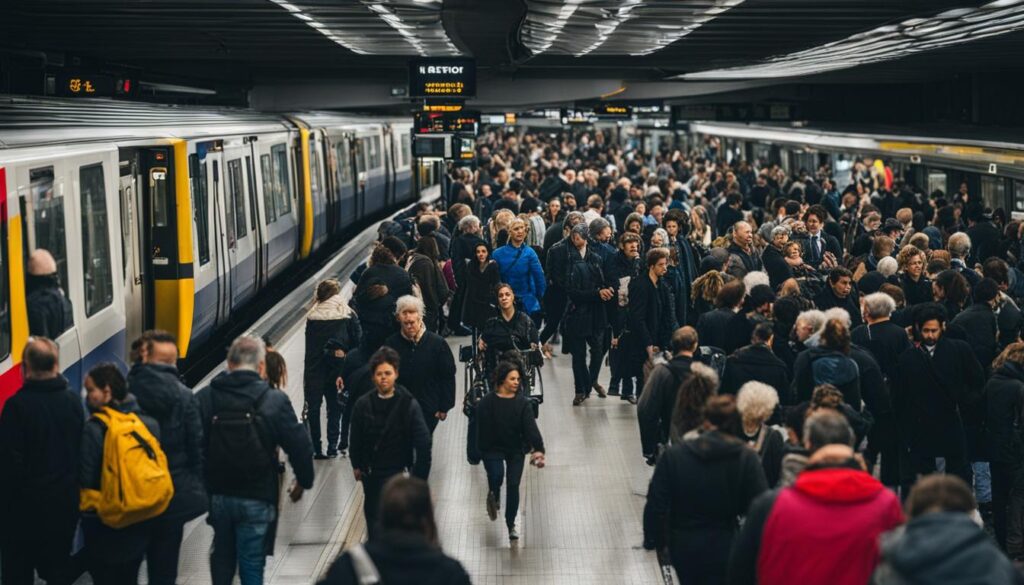Welcome to our comprehensive guide on how to use the French public transportation system. If you’re planning a trip to France, or if you’re a resident who needs to navigate the country’s public transport network, this guide is for you. With our tips and best practices, you will learn how to use the French public transportation system efficiently, ensuring a stress-free travel experience. This guide covers everything you need to know about public transportation in France, from understanding the different modes of transport to purchasing tickets and planning your route.
Introduction to the French Public Transportation System
When traveling to France, using the public transportation system can be a great way to get around the country. However, it can be quite daunting if you’re not familiar with the system. Therefore, it’s essential to have a basic understanding of how it works.
Understanding the French Public Transportation System
France has a comprehensive public transportation system that spans the whole country. It includes buses, trams, metros, and regional trains. These different modes of transportation are operated by various companies, including the national railway company SNCF and regional public transport authorities.
Much of the public transportation in France is integrated, meaning it’s possible to use a combination of modes to reach your destination. For example, you might take a metro to a train station, then switch to a bus to reach your final destination. It’s essential to keep this in mind when planning your route.
Essential Information on Using Public Transport in France
When using public transportation in France, it’s important to have the necessary information to make your trip as smooth as possible. Here are a few things to keep in mind:
- Timetables and schedules vary depending on the mode of transportation and the location. Therefore, it’s essential to check the schedules before you travel.
- French public transportation is generally reliable, but strikes can occur. It’s important to stay informed about any strikes that might be happening during your trip.
- France has an excellent transportation safety record, and security measures are in place to ensure passenger safety.
- Most public transportation in France makes accommodations for passengers with disabilities. However, it’s essential to check with the specific mode of transportation before traveling.
By keeping these essential pieces of information in mind, you will be better equipped to use the French public transportation system efficiently.
Types of Public Transportation in France
France offers a diverse range of public transportation services that cater to the needs of both tourists and locals. The most popular modes of transportation include bus, tram, metro, and regional trains.
The bus network in France is extensive, covering both urban and suburban areas. If you’re looking for an affordable and efficient way to travel short distances, taking the bus is a great option. Bus routes are mapped out on a dedicated website, with detailed information on schedules and fares.
Trams are another popular mode of transportation in France. The tram network is prevalent in major cities such as Paris, Lyon, and Marseille, providing a convenient and eco-friendly way to travel. Trams run on a dedicated track, which means they are not subject to traffic congestion and are generally faster than buses.
The metro system in France is a fast and efficient way to travel within major cities. The Paris Metro is the most well-known metro system in France, with 14 lines and over 300 stations. Other cities like Lyon, Lille, and Marseille have their own metro systems, which are smaller but equally efficient.
Regional trains, also known as TER (Transport Express Regional), are ideal for those who want to explore different regions of France. Regional trains are comfortable and frequent, with routes connecting major cities and smaller towns alike. Fares are affordable, and buying tickets in advance can result in even more savings.
To get the most out of your trip to France, it’s essential to understand the different types of public transportation available. Whether you’re looking for a budget-friendly option or a fast and efficient way to travel, there’s a mode of transportation that will suit your needs.
Purchasing Tickets and Passes
Using public transport in France can be an efficient and cost-effective way to get around, but it’s important to understand the ticketing system. There are several options for purchasing tickets and passes, so it’s essential to choose the one that best fits your needs and travel plans.
Types of Tickets and Passes
In France, you can purchase tickets for individual trips, or passes that allow for unlimited travel within a certain period. Here are some of the most common options:
- Single-Trip Ticket: This ticket is valid for one trip on a specific route and can be purchased at ticket machines, ticket counters, or through mobile apps.
- Day Pass: This pass allows for unlimited travel within a certain zone for one day and is often a good choice for tourists. It can be purchased at ticket machines, ticket counters, or through mobile apps.
- Weekly or Monthly Pass: These passes offer unlimited travel within a certain zone for a week or a month, respectively. They can be purchased at ticket counters or through subscription services.
- Multi-Day Pass: This pass allows for unlimited travel within a certain zone for consecutive days. It is often a good option for those staying in France for several days but not an entire week, as it can be more cost-effective than purchasing individual day passes. It can be purchased at ticket counters or through subscription services.
Purchasing Tickets and Passes
The easiest way to purchase tickets and passes is by using the ticket machines located in metro stations, near bus stops, or in train stations. These machines accept cash and credit cards and offer instructions in multiple languages, including English.
If you prefer to purchase tickets in person or have questions about the ticketing system, you can visit a ticket counter. These are usually located in metro stations and train stations and offer assistance in English.
You can also use mobile apps to purchase tickets and passes, including the official app for the French public transportation system, RATP. These apps often offer discounts and promotions and allow you to save your ticket or pass on your phone, eliminating the need for a physical ticket.
Ticket Validation
When using public transport in France, it’s essential to validate your ticket before boarding. This can be done at the validation machines located at the entrance to metro stations or on buses and trams. Failure to validate your ticket can result in a fine.
Rules and Regulations
There are a few important rules to be aware of when using public transport in France. For example, smoking is prohibited on all forms of public transport, and eating and drinking are not allowed on buses and trams. Additionally, seats should be given up to seniors, disabled individuals, and pregnant women.
By understanding the ticketing system and following the rules and regulations, you can use the French public transportation system efficiently and enjoy a stress-free travel experience.
Planning Your Route
When it comes to navigating public transport in France, planning your route is essential. Fortunately, there are many resources available to help you plan your journey.
Online Route Planners
One of the easiest ways to plan your route is to use an online route planner. These tools allow you to enter your starting point and destination to find the most efficient route using public transport. Some popular options include:
- RATP
- Transilien
- OUI.sncf
Mobile Apps
Another convenient option for planning your route is to use a mobile app. These apps often provide real-time updates and alerts for any changes or delays to your journey. Some popular options include:
- RATP app
- Citymapper
- Moovit
Maps
Finally, you can always refer to maps to plan your route. Most public transport stations have maps available that show the lines, stops, and connections. You can also find maps online or in guidebooks.
Whether you prefer online route planners, mobile apps, or traditional maps, planning your route in advance can save you time and hassle when navigating public transport in France.
Using the Metro in France
Paris has an extensive metro system and it is an efficient mode of transport to get around the city. When using the metro system, keep the following tips in mind to make your journey smooth and hassle-free:
- Plan your route in advance: Use a route planner to determine the best route to your destination. The official metro website offers a route planner, and there are also several mobile apps available, such as Citymapper.
- Know the line you need: Make a note of the line and direction you need to take to get to your destination.
- Purchase your ticket before you board: Tickets can be purchased at machines in the station or at ticket counters. Always keep your ticket with you until the end of your journey as you may be asked to present it by a ticket inspector.
- Use the correct entrance: Some stations have separate entrances for entering and exiting. Look for the signs indicating which entrance to use.
- Follow the rules: Always stand behind the yellow line on the platform and wait for passengers to exit the train before boarding.
- Be aware of pickpockets: Unfortunately, pickpocketing is a common occurrence on the metro in Paris. Keep your belongings close to you and be vigilant.
Other major cities in France, such as Lyon, Marseille, and Toulouse, also have metro systems. Make sure to check their official websites for information on fares, routes, and schedules before your trip.
Taking Buses and Trams in France
Buses and trams are popular modes of public transportation in France. They provide extensive coverage in both urban and suburban areas, making it easy for you to get around. Here are some tips for using the bus and tram networks efficiently:
Understanding the bus and tram networks
France has an extensive network of buses and trams that operate in most cities and towns. The routes are often clearly marked and well connected, making it easy to plan your journey.
Purchasing tickets and passes
To use the bus or tram, you need to have a valid ticket or pass. You can purchase tickets from vending machines at bus and tram stops, as well as from ticket offices in train stations. It’s also possible to buy tickets and passes in advance from some retailers.
There are different types of tickets and passes available for use on the bus and tram networks. Some options include:
| Type of Ticket/Pass | Description |
|---|---|
| Single-use ticket | Valid for a single journey on a bus or tram |
| Daily pass | Valid for unlimited travel on bus and tram networks for one day |
| Weekly pass | Valid for unlimited travel on bus and tram networks for one week |
Planning your journey
It’s important to plan your journey in advance to avoid any confusion or delays. You can use online route planners, mobile apps, and maps to help plan your route. Make sure to check the bus and tram schedules and plan accordingly.
You can also use the RATP (Régie Autonome des Transports Parisiens) official public transport app to help you plan your journey, check schedules, and purchase tickets.
Boarding the bus or tram
When waiting for the bus or tram, make sure to stand at the designated stop. When the bus or tram arrives, wait for passengers to exit before boarding.
Once onboard, make sure to validate your ticket or pass using the onboard validation machines. Failure to do so can result in a fine.
Useful tips
- Keep your ticket or pass with you at all times, as you may be required to show it during your journey.
- Avoid traveling during peak hours if possible, as the bus and tram networks can become crowded.
- Be aware of your surroundings and keep your belongings close to you to avoid pickpocketing.
Exploring Regional Trains
If you’re looking to explore different regions of France, regional trains are a convenient and efficient option. With a vast network of regional trains running throughout the country, traveling by train is often the best way to reach more remote destinations.
Booking tickets for regional trains can be done online, in person at a train station, or through a ticket machine. It’s important to note that some trains may require reservations, so be sure to check the requirements beforehand.
Understanding the schedules of regional trains is key to making connections and planning your trip efficiently. You can use the SNCF website to check schedules and routes, and plan your journey accordingly.
Regional trains offer a variety of seating options, including standard and first-class seats. Some trains also offer dining cars and other amenities to make your journey more comfortable.
| Advantages | Disadvantages |
|---|---|
| Efficient and convenient | May require reservations |
| Connects remote destinations | Less frequent than local trains |
| Comfortable seating options | Can be more expensive |
As with other modes of public transport in France, it’s important to validate your ticket before boarding the train. Once on board, sit back and enjoy the scenic journey through France’s picturesque countryside.
Understanding Timetables and Schedules
When using public transportation in France, it is essential to understand the timetables and schedules to plan your journey effectively. Here are some best practices for interpreting and using timetables:
- Familiarize yourself: Before you start your journey, take some time to familiarize yourself with the timetable of the public transport system you will be using. This will help you better understand the frequency of the service and plan your route accordingly.
- Reading the timetable: Timetables usually include the names of the different stops or stations, the departure and arrival times of the services, and the frequency of the service. The departure times are shown on the left side of the timetable, while the right side displays the corresponding arrival times. The frequency of the service is usually indicated in minutes and can be found in the middle of the timetable.
- Frequency: Understanding the frequency of public transport services is essential when it comes to planning your journey. You can easily determine the frequency of the service from the timetable, which will help you decide when to start your journey.
- Planning your journey: Once you understand how to read timetables, planning your journey becomes much easier. Use the timetable to determine the best time to start your journey and the duration of the trip.
It’s also essential to consider the schedules of other services, such as connecting services or services that operate at different times on weekends and holidays. Make sure to check if there have been any changes to the timetables due to public holidays, special events, or inclement weather. Keeping these tips in mind will help you effectively use the French public transportation system and ensure a smooth travel experience.
Tips for Using the French Public Transportation System
Using public transportation in a foreign country can be intimidating, but with some helpful tips, you’ll be able to navigate the French public transport system with ease. Follow these best practices to ensure a stress-free travel experience:
1. Plan ahead
Before embarking on your journey, take the time to plan your route using the many available resources such as online route planners, mobile apps, and maps. This will help you avoid confusion and ensure that you arrive at your destination on time.
2. Validate your ticket
Once you’ve purchased your ticket or pass, be sure to validate it using the machines located on buses, trams, and metro stations. Failure to do so can result in a fine.
3. Mind the gap
When boarding trains or metro cars, be sure to mind the gap between the platform and the train. This will prevent accidents and ensure a safe journey.
4. Be aware of rush hour
Rush hour in France is typically between 7am-9am and 5pm-7pm. Be prepared for crowded trains and longer wait times during these periods.
5. Keep your belongings safe
Be mindful of your surroundings and keep your belongings close to you at all times. Pickpocketing is a common problem on public transportation in France, so it’s important to remain vigilant.
6. Don’t be afraid to ask for help
If you’re unsure of something or need assistance, don’t hesitate to ask a fellow passenger or public transportation employee. Many people are happy to help and can provide valuable information.
“By following these tips, you’ll be able to navigate the French public transport system like a pro, ensuring a stress-free travel experience.”
Accessibility and Special Considerations
If you have specific accessibility needs or require special considerations while using public transportation in France, it’s crucial to plan ahead to make your travel experience as smooth as possible.
The French public transportation system has made significant efforts to accommodate individuals with disabilities. However, the level of accessibility may vary depending on your specific needs and the type of transportation you plan to use.
If you use a wheelchair or have limited mobility, it’s recommended that you contact the transportation company in advance to ensure that the vehicle and station you plan to use are accessible. Some buses and trams have a ramp or a wheelchair lift, but not all stops have level boarding. Regional trains usually have a designated area for wheelchair users, but it’s essential to reserve a space in advance.
If you have a visual or hearing impairment, the public transportation system also provides assistance services to help you navigate the network. For example, the RATP (Regie Autonome des Transports Parisiens) offers an assistance service called Acces Plus for individuals with disabilities or reduced mobility. This service is available for users of the Paris metro, RER, and bus lines.
Additionally, if you are traveling with a service animal, they are permitted on all forms of public transportation in France.
Overall, navigating public transport in France with accessibility needs requires planning and research. However, with the right preparation, you can confidently use the French public transportation system and enjoy your travels.
Conclusion
You now have the knowledge and tools to use the French public transportation system efficiently and stress-free. By following the tips and information provided in this comprehensive guide, navigating France’s public transport network will be a breeze.
Remember, planning your route is key to a smooth travel experience. Use the available online resources, such as route planners and maps, to plan your journey and avoid unnecessary confusion or delays.
Choose the best mode of transport for your needs, whether it’s the metro, bus, tram, or regional train. Purchase your tickets and passes in advance so that you can travel with ease, knowing you have everything you need.
Reading and interpreting timetables can seem daunting at first, but with practice, you will become a pro. Use the provided tips to understand frequency, plan connections, and ensure you arrive at your destination on time.
Finally, remember to be respectful and courteous to fellow passengers and follow safety measures. If you have specific accessibility needs or require special considerations, do not hesitate to seek out the services and facilities available.
With this guide at your fingertips, you can confidently use the French public transportation system like a local. Have a great trip!
















































